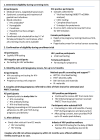Preventing HIV and achieving pregnancy among HIV sero-different couples: Pilot study of a safer conception intervention in Zimbabwe
- PMID: 36963004
- PMCID: PMC10022125
- DOI: 10.1371/journal.pgph.0000796
Preventing HIV and achieving pregnancy among HIV sero-different couples: Pilot study of a safer conception intervention in Zimbabwe
Abstract
Safer conception services are needed to minimize HIV transmission among HIV sero-different couples desiring pregnancy. Few studies have evaluated the choices couples make when offered multiple safer conception methods or real-world method acceptability and effectiveness. We piloted a comprehensive safer conception program (Clintrials.gov identifier: NCT03049176) for HIV sero-different couples planning pregnancy in Zimbabwe to measure feasibility, method uptake, acceptability, pregnancy outcome, and HIV transmission. This study was not designed to compare rates of HIV transmission by safer conception method choice but rather to understand choices couples make when seeking to minimize risk of HIV transmission and maximize likelihood of pregnancy. Couples in this prospective, non-randomized study were given a choice of one or more currently available safer conception methods: antiretroviral therapy (ART) with monthly viral load (VL) monitoring for the HIV-positive partner (ART/VL), pre-exposure prophylaxis (PrEP) for the HIV-negative partner, vaginal insemination (VI) for couples with an HIV-positive woman, and semen washing (SW) for couples with an HIV-positive man. Couples were followed monthly for up to 12 months of pregnancy attempts, quarterly during pregnancy, and 12 weeks post-partum. At each visit, data on method use, urine for pregnancy testing, and blood for HIV antibody testing, or viral load if HIV-positive, were obtained. Infants born to HIV-positive women were tested for HIV at 6 and 12 weeks. Between March 2017 and June 2019, 46 individuals from 23 HIV sero-different partnerships were enrolled and followed. At enrollment, all couples chose ART/VL, and all couples chose at least one additional method; 74% chose PrEP, 36% chose SW, and 25% chose VI. During pre-pregnancy follow-up visits, three couples discontinued SW, and one couple discontinued VI; all four of these couples opted for ART/VL plus PrEP. Satisfaction with safer conception methods was high among those who chose ART/VL and PrEP. Twelve couples achieved pregnancy. There were no cases of HIV transmission to partners, and no infants tested positive for HIV. This safer conception program is feasible and acceptable, allowing sero-different couples to safely achieve pregnancy. Sero-different couples in Zimbabwe seek a combination of HIV prevention methods, particularly ART/VL plus PrEP. Trial Registration: Clintrials.gov, NCT03049176.
Copyright: © 2023 Brown et al. This is an open access article distributed under the terms of the Creative Commons Attribution License, which permits unrestricted use, distribution, and reproduction in any medium, provided the original author and source are credited.
Conflict of interest statement
The authors have declared that no competing interests exist.
Figures







References
-
- UNAIDS Data 2021, Geneva: Joint United Nations Programme on HIV/AIDS; 2021. Licence: CC BY-NC-SA 3.0 IGO. Available at: https://www.unaids.org/en/resources/documents/2021/2021_unaids_data
-
- Schwartz SR, Mehta SH, Taha TE, Rees HV, Venter F, Black V. High pregnancy intentions and missed opportunities for patient-provider communication about fertility in a South African cohort of HIV-positive women on antiretroviral therapy. AIDS Behav. 2012;16(1):69–78. doi: 10.1007/s10461-011-9981-3 - DOI - PubMed
Associated data
Grants and funding
LinkOut - more resources
Full Text Sources
Medical
Miscellaneous
